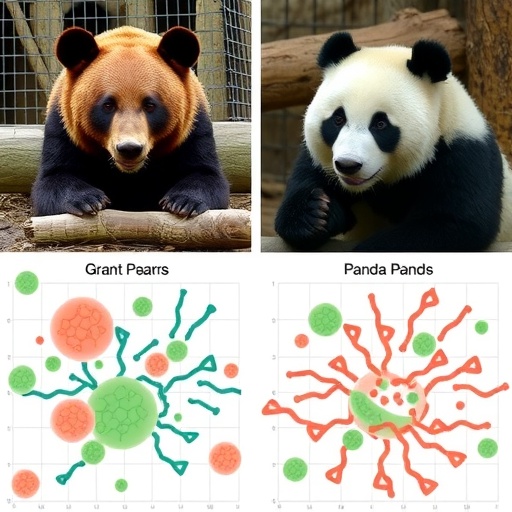In a groundbreaking study that delves deep into the unseen world of gut microbiomes, scientists have uncovered profound differences in the microbial communities of bears and pandas living in captivity compared to their wild counterparts. This research not only highlights the dramatic impact of captivity on the gut ecosystems of these iconic species but also reveals a striking reduction in microbial diversity in captive giant pandas, underscoring the complex interplay between environment, diet, and health.
The gut microbiome, an intricate network of microorganisms residing in the digestive tracts of animals, plays a pivotal role in digestion, immunity, and overall health. For species such as giant pandas (Ailuropoda melanoleuca), red pandas (Ailurus fulgens), and Asiatic black bears (Ursus thibetanus), this microbial community is crucial for processing their unique diets, which are rich in fibrous plant material and specialized nutrients. Captivity, with its altered diets, sterile environments, and different stressors, presents a vastly different landscape for these microbes.
By conducting a cross-species analysis, researchers meticulously compared the gut microbiota of captive and wild individuals from three bear and panda species. Employing advanced genomic sequencing techniques, they mapped the microbial composition and diversity, revealing that captivity induces significant alterations in microbial communities. While all species showed changes, the giant panda’s gut microbiome exhibited the most pronounced reduction in diversity. This loss of microbial variety could have serious implications for their health, immune function, and ability to digest bamboo efficiently.
The study further elaborates on how the microbiome shifts in captivity are characterized by a decrease in beneficial bacterial taxa typically associated with fiber degradation and nutrient synthesis. These changes suggest a reduced functional capacity of the gut microbiome, potentially compromising the animals’ digestive efficiency and resilience against pathogens. In contrast, wild bears and pandas maintain a rich and stable microbial ecosystem that supports their specialized dietary needs and metabolic health.
Interestingly, the red panda and Asiatic black bear showed divergent patterns of microbiota reshaping compared to the giant panda, reflecting how species-specific biology and diet interact with environmental factors. This complexity emphasizes that management and conservation strategies cannot adopt a one-size-fits-all approach but must consider the unique microbiological and ecological requirements of each species.
Scientists involved in the study underscored the role of diet in microbiome diversity. Captive diets, often less varied and lacking certain fiber types or natural food components, profoundly influence gut microbiota structure. For the bamboo-specialist giant panda, these dietary alterations in captivity appear to be especially detrimental. The findings suggest that dietary enrichment with natural foraging components or microbiota-targeted interventions may help restore beneficial microbes and enhance health outcomes.
Methodologically, this ambitious project integrated high-throughput sequencing with rigorous bioinformatics analyses to profile bacterial taxa at high resolution. Such detailed microbial community analyses shed light on functional capacities, enabling predictions about how shifts in microbial populations translate into changes in digestive efficiency and immune function. This approach represents a powerful tool for wildlife biology and conservation medicine.
The implications of this research extend beyond gut health. Microbiome alterations may influence behavior, reproduction, and disease susceptibility—factors critical for the success of conservation breeding programs. Understanding how captivity reshapes microbiota offers deep insights into the “hidden” physiological stressors these animals endure, often invisible to caretakers but influential on long-term viability.
Given the accelerating pace of habitat loss and increasing reliance on captive populations for species survival, these findings carry urgent conservation significance. The study encourages zoological institutions and wildlife managers to adopt microbiome-informed practices, including monitoring and manipulating gut microbial communities as part of overall animal welfare protocols. Such microbiome stewardship could improve health outcomes and reproductive success, ultimately supporting species preservation.
Beyond wildlife conservation, these insights may inform broader research on host-microbiome interactions and their role in health and disease. The study exemplifies how environmental factors, lifestyle, and diet uniquely converge to shape microbial landscapes, influencing host well-being. This paradigm has parallels in human microbiome research, where lifestyle changes and industrialized diets similarly impact microbial diversity and health.
In conclusion, captivity inflicts profound and species-specific alterations on the gut microbiotas of pandas and bears. Giant pandas, with their specialized diets, exhibit the most significant losses in microbial diversity, raising critical questions about the long-term health consequences of life in captivity. Addressing these microbial shifts through innovative dietary and microbiological interventions offers a promising frontier for improving captive animal care and ensuring the survival of these beloved species in an increasingly human-dominated world.
Subject of Research: Gut microbiome differences between captive and wild giant pandas, red pandas, and Asiatic black bears.
Article Title: Captivity-driven microbiota reshaping: A cross-species analysis of divergent patterns in the gut microbiota of giant pandas (Ailuropoda melanoleuca), red pandas (Ailurus fulgens), and Asiatic black bears (Ursus thibetanus)
News Publication Date: 8-Oct-2025
Web References: 10.1371/journal.pone.0332481
Image Credits: Wei Guo, CC-BY 4.0
Keywords: gut microbiome, captivity, giant panda, red panda, Asiatic black bear, microbial diversity, diet, conservation biology, microbiota reshaping, wildlife health




